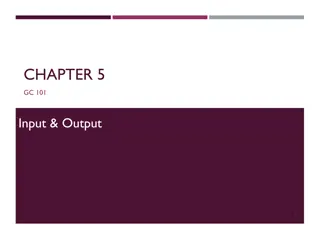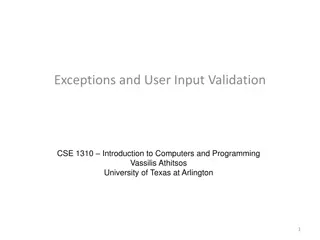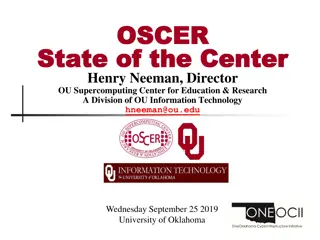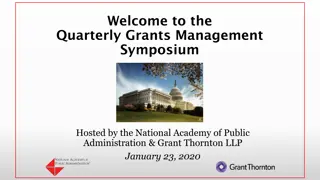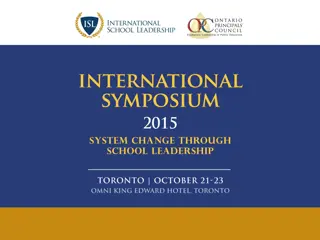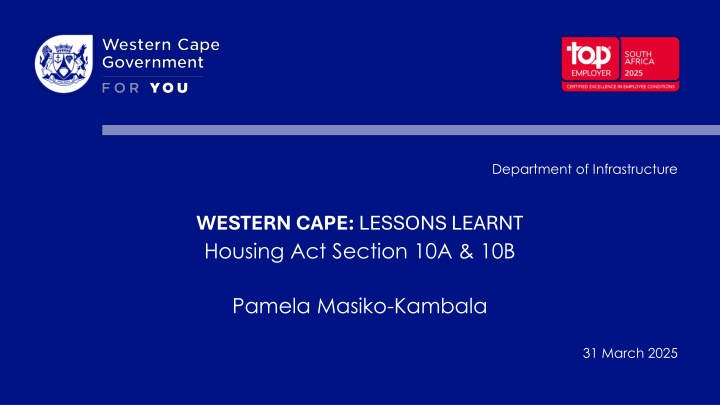
Lessons Learned from Pre-1994 Housing Policies in Western Cape
Explore the history and intent behind the housing program in South Africa before 1994, focusing on discussions, negotiations, and the resulting housing policy. Discover the shift towards state-driven, market-assisted housing with an emphasis on private ownership as a means of asset creation for low-income households. Critiques of neo-liberal land titling policies and the complexities of formalizing property rights are also examined.
Download Presentation

Please find below an Image/Link to download the presentation.
The content on the website is provided AS IS for your information and personal use only. It may not be sold, licensed, or shared on other websites without obtaining consent from the author. If you encounter any issues during the download, it is possible that the publisher has removed the file from their server.
You are allowed to download the files provided on this website for personal or commercial use, subject to the condition that they are used lawfully. All files are the property of their respective owners.
The content on the website is provided AS IS for your information and personal use only. It may not be sold, licensed, or shared on other websites without obtaining consent from the author.
E N D
Presentation Transcript
Department of Infrastructure WESTERN CAPE: LESSONS LEARNT Housing Act Section 10A & 10B Pamela Masiko-Kambala 31 March 2025
Pre 1994: History & Intent of the Housing Programme Before 1994, various discussions had taken place in the country on housing policy and the right to housing in the looming political transition. The talks focused on addressing the needs of the landless Black majority, particularly in urban areas (e.g. context of Dompas & forced removals) The current housing policy/programme is the outcome of a process of intense negotiation within the National Housing Forum (NHF) from 1992 to 1994 (Huchzermeyer, 2001:304) Founded in August 1992, the NHF brought together a wide range of stakeholders and drew into its structures and processes erstwhile opponents of the National Party government, namely, civic associations, AZAPO, ANC, trade unions, provincial and local authorities, banks, the private sector, and other interest groups, to formulate a national housing accord, once discussions began in November 1991 (Thomas, 2010:219) These NHF negotiations culminated in the National Housing Summit led by Joe Slovo, South Africa's first Housing Minister in the democratic era. In October 1994, over 1,000 delegates at the summit held in Botshabelo township (Free State province), adopted the National Housing Accord, known as the Botshabelo Accord. It included a target of building one million houses within the first five years of democracy, a highly visible element of the ANC s election manifesto
Goal: State-driven, Market Assisted, Private Ownership = Asset Creation A key debate within these discussions focused on the preferred types of land tenure and housing typologies to address South Africa's housing challenges. Unions and civic organisations advocated for a state-driven, market-assisted, low- income housing process, with a strong preference for private ownership through individual freehold. This approach was seen as a means of achieving redress, driving transformation, and enabling asset creation for low- income households. Ultimately, the negotiations led to a housing policy that primarily emphasised freehold tenure, reflecting the government's and private sector's preferences While individual freehold ownership was prioritised over other tenure options, housing policy and subsidies to date also make provision for social and rental housing, as well as informal settlement upgrading Moreover, a growing body of academic critique later emerged against the so-called neo-liberal land titling policies championed by the Peruvian economist Hernando de Soto. De Soto s book, The Mystery of Capital (2000), elevated the importance of property rights in driving economic development and asset creation in low-income households. His argument that formalising property rights through individual land titling would unlock economic potential for the poor gained significant traction within global financial institutions, but was heavily critiqued Cautions were that the assumed preconditions for asset accumulation do not necessarily materialise and that no guarantee that formalised land ownership will deliver the anticipated developmental benefits. Other critics contend that while de Soto s policies may appear attractive in theory, they often overlook the complexities of local socio- economic realities, disrupt well-functioning customary tenure systems, and fail to address the entrenched structural inequalities in land ownership
Purpose of the Clause Historically, state-subsidised houses were transferred without restrictions on title = rapid sales for short-term gain Daily Maverick, 16 July 2013
Cases symbolic of broader socio-economic issues The phenomenon driven by: 1. Poverty and desperation homes sold for immediate financial relief (e.g., paying off debts or covering funeral expenses) 2. Lack of awareness of property value beneficiaries were unaware of hidden state subsidies, such as land costs or even the true property value, escalation/appreciation asset) 3. Exploitation by informal buyers beneficiaries were often enticed into informal sales in exchange for cash 4. Absence of post-occupation support no government assistance was provided to educate homeowners on property value and tenure security These trends undermined asset creation and conflicted with the state s intention of providing long-term housing security for low-income households. Hernando de Soto s The Mystery of Capital (2000) re: enabling asset creation for low-income households James C Scott (1998) on state intent re: Seeing like a State on state-led fixation on standardisation and legibility and its quest to simplify ownership legibility Sarah Charlton (2013: 370): [T]he state sets out to control beneficiary practices (through the pre-emptive clause in the title deeds) but is unable to maintain control of its own records and oversight. These insights assist in understanding the pressures on the state and the limits of its abilities in controlling a large-scale, complex and multi-faceted programme.
Legislative intent of the Clause The pre-emptive right clause was inserted into the Housing Act in 2001 (7-years into democracy), with the following objectives: 1. Preventing downward raiding to protect beneficiaries from selling their homes at below- market value due to financial hardship or coercion 2. Preserving housing stock & preventing gentrification to ensure that state-funded housing remained available for low-income households 3. Curbing informal sales & tenure insecurity by preventing unregistered property transactions that led to legal disputes and unauthorised occupations 4. Promoting stability & sustainable settlements to prevent displacement and encourage long- term community development BNG called for the reduction of 8 years to 5 never been implemented legally/ Housing Act never amended to this effect
Impact on housing policy By 2004, the Breaking New Ground (BNG) policy acknowledged the potential of government-subsidised housing to stimulate the secondary residential property market. This recognition marked a policy shift, linking primary and secondary housing markets for the first time. The BNG policy noted that: Title deed backlogs hindered participation in the formal property market. The inability to sell homes restricted mobility, limiting economic opportunities and effectively made it difficult for households to rise up the property ladder Unlocking the resale market could enhance asset-creation potential [T]he consequence of such titling backlogs is that residents are not able to participate in the residential property market. This undermines their mobility (and their ability to access work where it is available), their choice (and their ability to find housing that corresponds with their specific needs), and the asset-creation potential of the state s investment in their housing. (Department of Housing, 2004:10).
Unintended consequences of the Clause While the clause addressed initial concerns, it also introduced new unintended consequences: 1) Overloading provincial departments - Provincial governments faced overwhelming workloads, managing the right of first refusal process. Act not retrospective Clause only applicable from 2001 2) Limited housing mobility for beneficiaries - beneficiaries needing to relocate (due to work opportunities, family reasons or unsafe living conditions) are stuck with properties they cannot legally sell, hindering economic mobility 3) Informal sales & illicit transactions - Many circumvented the clause by selling informally, leading to unregistered ownership, legal disputes, and tenure insecurity (Cloudy & Dead Man s titles) 4) Market Distortion - Restrictions stifled natural property market development, reducing incentives for homeowners to invest in property improvements 5) Economic Constraints - Homeowners were unable to leverage their property as collateral for business or educational loans, hindering economic upliftment
Post- FLISP policy challenges The removal of Section 10B regarding First Home Finance introduced further complications, particularly for financial institutions. New provisions require banks to include a right of first refusal to the MEC before proceeding with foreclosures. This poses challenges: Unclear criteria uncertain under what conditions can an MEC accept or reject a property sale Bank hesitancy Financial institutions may withdraw from lending due to uncertainty about government intervention Property valuation concerns Issues such as unlawful extensions, property conditions, and pricing complicate state buy-back decisions
Experiments with the Clause: WC Waiver Policy A waiver policy was introduced in 2014 to discourage subsidy leakage, approved by MEC, allowing beneficiaries to transact under specific conditions: The buyer must be an SA citizen and must not have previously owned property The seller must have occupied the home for a minimum of two years The sale must improve the seller s living standards (relocating/moving up property ladder) Municipal approval is required for transactions within five years Exceptions apply in cases of divorce or deceased estates Deeds Office requires: Within the 8-year period: a letter of no objection that the 10A and 10B can be removed Post the 8-year period: a letter of no objection that 10A has expired & that 10B can be removed Dept has never taken properties back. Issues: condition, unlawful extensions, outstanding rates, etc. Definition acquire means when a beneficiary s subsidy was approved or when he/she took occupation vs registration (as this can differ greatly due to registration delays)
Application statistics & High Application Volumes 2023/24: 1,372 applications (60% expired, 40% non-expired cases) 2024/25: 2,010 applications (63% expired, 37% non-expired cases) Limited Public Awareness The waiver policy is not well-known or advertised. Administrative Burden Managing waiver applications places a significant strain on provincial resources. Policy Implementation & Challenges A huge administrative burden on the province, partially effective and requires adequate personnel resources to be effective & efficient Maintaining 8 years or amending the period to 5 years will not reduce the administrative burden, esp. due to expired cases. NDHS may need to consider supportive instruments White Paper process suggestions made that NDHS considers and endorses it
Key questions for policy consideration What is/are the real concern(s) with the Clause? Formal vs informal sales Clause addresses ONLY formal sales Is there a need to protect subsidy property via a sale restriction against downward raiding and gentrification? What are the persistent barriers to a functioning secondary residential property market, as it is somewhat dysfunctional at the lower end of the market? Anything to say about the title deed backlog of over 1m properties who/ what created the backlog? How do we think it shapes/manifests in the property market? Our take on unregularised, dead man s/ cloudy titles? Any policy changes required? Options should be assessed for their probable impact on discouraging informal sales and encouraging formal sales. Given the consequences of informal sales are significantly negative at an individual and societal level, measures that lead to informal sales should be strongly avoided Administrative feasibility and cost are key assessment requirements. The cost for provincial departments to set up systems to take back property offered by beneficiaries and compensate the former beneficiary is likely to be substantial.
Questions while tinkering with the Clause (2) If we say informal transactions dominate the resale activity, undermining formal market growth and leaving sellers vulnerable to exploitation, what evidence do we have to back this up? What makes the informal market thrive despite huge unintended, long-term and lifetime consequences, especially to the purchasers? Does an average citizen know the property transaction process? Is it the same in rural vs urban areas? What is the transacting cost at what point does an average person know of this? How long does it take? Who are the parties involved Seller/Purchaser, Estate Agents, Community Actors, Conveyancers, Deeds Office?





